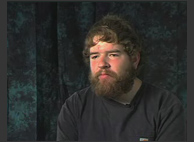| NIMH: Autism Spectrum Disorders | |
| NICHD: Autism and the MMR Vaccine | |
| Richard, Age 52 | |
| Jeff, Age 35 | |
| NIMH: Autism Spectrum Disorders (pdf) | |
| CDC: Learn the Signs Information Card (pdf) | |

Autism Spectrum Disorders (Pervasive Developmental Disorders)
A detailed booklet that describes symptoms, causes, and treatments, with information on getting help and coping. PDF
Not until the middle of the twentieth century was there a name for a disorder that now appears to affect an estimated 3.4 every 1,000 children ages 3-10, a disorder that causes disruption in families and unfulfilled lives for many children. In 1943 Dr. Leo Kanner of the Johns Hopkins Hospital studied a group of 11 children and introduced the label early infantile autism into the English language. At the same time a German scientist, Dr. Hans Asperger, described a milder form of the disorder that became known as Asperger syndrome. Thus these two disorders were described and are today listed in the Diagnostic and Statistical Manual of Mental Disorders DSM-IV-TR (fourth edition, text revision)1 as two of the five pervasive developmental disorders (PDD), more often referred to today as autism spectrum disorders (ASD). All these disorders are characterized by varying degrees of impairment in communication skills, social interactions, and restricted, repetitive and stereotyped patterns of behavior.
The autism spectrum disorders can often be reliably detected by the age of 3 years, and in some cases as early as 18 months.2 Studies suggest that many children eventually may be accurately identified by the age of 1 year or even younger. The appearance of any of the warning signs of ASD is reason to have a child evaluated by a professional specializing in these disorders.
Parents are usually the first to notice unusual behaviors in their child. In some cases, the baby seemed "different" from birth, unresponsive to people or focusing intently on one item for long periods of time. The first signs of an ASD can also appear in children who seem to have been developing normally. When an engaging, babbling toddler suddenly becomes silent, withdrawn, self-abusive, or indifferent to social overtures, something is wrong. Research has shown that parents are usually correct about noticing developmental problems, although they may not realize the specific nature or degree of the problem.
The pervasive developmental disorders, or autism spectrum disorders, range from a severe form, called autistic disorder, to a milder form, Asperger syndrome. If a child has symptoms of either of these disorders, but does not meet the specific criteria for either, the diagnosis is called pervasive developmental disorder not otherwise specified (PDD-NOS). Other rare, very severe disorders that are included in the autism spectrum disorders are Rett syndrome and childhood disintegrative disorder. This brochure will focus on classic autism, PDD-NOS, and Asperger syndrome, with brief descriptions of Rett syndrome and childhood disintegrative disorder on the following page.
- Addendum February 2007
- Rare Autism Disorders
- What Are the Autism Spectrum Disorders?
- The Diagnosis of Autism Spectrum Disorders
- Available Aids
- Treatment Options
- Adults with an Autism Spectrum Disorder
- Research into Causes and Treatment of Autism Spectrum Disorders
- References
- Citation
NIH Publication No.04-5511
April 2004,
Addendum February 2007



